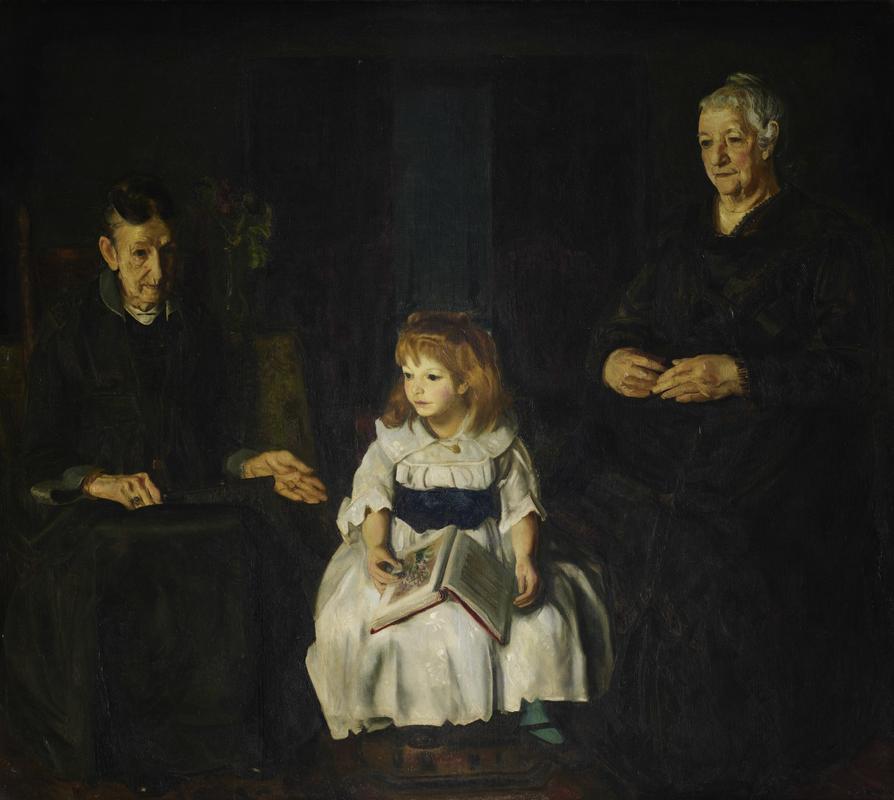More about Elinor, Jean and Anna

Contributor
George Bellows composed Elinor, Jean, and Anna in the bucolic town of Woodstock, New York.
For some people born in the '80's, Woodstock may conjure an image of Fred Durst, lead yeller of the now-vintage band Limp Bizkit, bellowing at a muddy, intoxicated mass of people at a concert called "Woodstock '99." Woodstock '99 was such a disaster that it is thankfully eclipsed in our cultural memory by the original festival, the 1969 "Aquarian Exposition: 3 Days of Peace & Music," which served as a watershed moment for disillusioned suburban teenagers who opposed the war in Vietnam.
Fifty years earlier, Bellows' Woodstock was a family escape from the high-pressure, concentrated grime of New York City, where the painter had achieved enormous critical acclaim by painting the struggles of poor and working class people. Elinor, Jean, and Anna shows, from left to right, the artist's maternal aunt, Fanny or Fannie Smith (AKA Elinor), the artist's daughter with Emma Story, Jean, and Anna Wilhelmina Smith Bellows, the artist's mother. Bellows adored his Aunt Fanny, who helped raise him as a child before moving to San Diego to be married. They corresponded frequently and visited with one another whenever possible. Though this painting is quite dark in color, there is a warmth expressed that signals Bellows' affection for his family. The two older women softly smile as they attend to the child, Fanny reaching out her hand to Jean in a gesture of tenderness, or even guidance. One gets the sense that Bellows, now in the later stages of his career and more focused on his family than ever, is appreciating the passage of time between generations, and the maternal love and care of the women in his life.
In her Vanity Fair review of Elinor, Jean, and Anna, subtitled "A Note on a Portrait by George Bellows of Three American Types," Ruth Suckow writes that both women, although from different generations, have "known what it is to work." "They keep the little girl between them," and the girl holds a book, which would have been unavailable to her elders when they were growing up in the country. Jean represents the third generation of the "pioneer" immigrant family. "They are proud of her golden hair, her white skin," which will never know the tanning of outdoor labor, "and her white dresses." She already has her own bank account, and, "just before her youth is over, she will marry exactly the right kind of person." Though this description makes the painting seem like celebration of his family's own financial success, Bellows nonetheless considered himself to be an advocate for the dispossessed of the world.
Sources
- Baldwin, James. The Evidence of Things Not Seen: Reissued Edition. New York: MacMillan, 1995.
- Berger, Martin A. Sight Unseen: Whiteness and American Visual Culture. Berkeley: University of California Press, 2005.
- Lears, Jackson. "George Bellows: New York knock-out." The Royal Academy, Feb. 27, 2013, https://www.royalacademy.org.uk/article/george-bellows-new-york.
- "Leaving the Country: George Bellows at Woodstock." TFAOI, http://www.tfaoi.com/aa/4aa/4aa158.htm.
- LIFE. Oct. 27, 1941.
- Magazine of Art, Volume 13, no. 8. New York: American Federation of Arts, 1922.
- Spaulding, Karen Lee. 125 masterpieces from the collection of the Albright-Knox Art Gallery. Buffalo, NY: Albright-Knox, 1987.
- Vanity Fair, Volumes 25-26. New York: Condé Nast, 1926.











